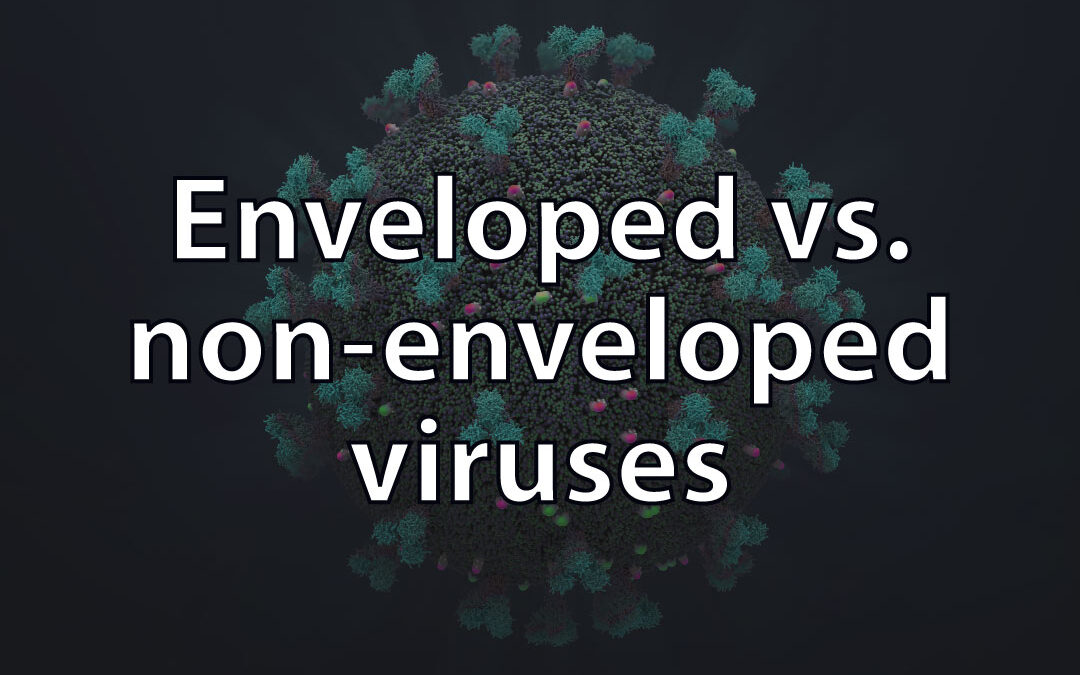We’re often asked, what’s the differences between enveloped and non-enveloped viruses, or should I test my product or drug against an enveloped or non-enveloped virus. Here we give some background on these two classes of viruses.
Almost 100 years studying virus structures
Virus structures began to be understood in the 1930s with Stanley, Bernal, and Fankuchen’s work with the tobacco mosaic virus (TMV). In the following years and decades, further studies attempted to understand the composition and structure of viruses, and much progress was achieved. Yet even now, we still don’t fully understand everything about virus structures, but we can classify and separate viruses according to their structure and composition.
Enveloped and non-enveloped viruses
One of the major and best-known virus classifications is the separation of enveloped from non-enveloped viruses. In general, what distinguishes them is the presence (for enveloped viruses) or absence (for non-enveloped viruses) of a lipid bilayer membrane on the outer part of the virus.
To understand this specific structural classification and the differences that arise from it, it’s important to know a little about the general virus structure. Viruses are composed of two main components: the viral genome (which can be RNA or DNA) and the virus-coded protein capsid that surrounds the genome. If the virus particle contains only these two elements, it is called a non-enveloped virus. If the virus particle contains an extra lipid bilayer membrane surrounding the protein capsid, it’s called an enveloped virus.
Non-enveloped viruses are typically more virulent
Non-enveloped viruses (also known as naked viruses) are typically more virulent than enveloped viruses. This is because they usually cause host cell lysis. This is one of the major differences between non-enveloped and enveloped viruses; let’s understand the reasoning behind that. Since non-enveloped viruses don’t have that extra lipid membrane, cell lysis is the most common exit mode from the host cell. During this event, the viruses violate the integrity of the cell membrane, causing cell death and significant tissue damage to the host organism. Non-enveloped viruses are more resistant to extreme pH, heat, dryness, and simple disinfectants. Some examples of non-enveloped viruses are norovirus, enterovirus, adenovirus, and rhinovirus.
Enveloped viruses are typically less virulent
On the other hand, enveloped viruses are typically less virulent than non-enveloped viruses. This is because they don’t always cause cell lysis during cell exit, although cell death often follows as a consequence of virus replication. Since enveloped viruses contain an outer membrane that surrounds the capsid, during virus assembly and exit from host cells, these viruses can use the host cell membrane itself to assemble their membrane, known as an envelope. This process avoids cell lysis and helps enveloped viruses escape the host’s immune system.
Enveloped viruses also tend to be more sensitive to extreme pH, heat, dryness, and simple disinfectants. Examples of enveloped viruses include: influenza, human cytomegalovirus (HCMV), HIV, respiratory syncytial virus (RSV), vaccinia virus, and human coronaviruses (such as NL63, 229E, OC43, and SARS-CoV-2).
Test against enveloped or non-enveloped viruses or both? We can help you decide
When testing the virucidal properties of a material or a formulation, it may be important to know whether it affects both enveloped and non-enveloped viruses, as only products that effect both can be called broad-spectrum. Because non-enveloped viruses are more resistant to harsh treatment conditions and also to a number of detergents, it is often important to prove activity against this group. Here at Virology Research Services, we offer a range of testing services using enveloped and non-enveloped viruses. When selecting the test and virus combination, it is important to understand how the differences between enveloped and non-enveloped viruses might impact the test outcomes. Luckily, our team of experts will always be available to help you plan experiments that match your research objectives. Contact us today, and one of our friendly team will get back to you.
REFERENCES:
Dimitrov, D. Virus entry: molecular mechanisms and biomedical applications. Nat Rev Microbiol 2, 109–122 (2004). https://doi.org/10.1038/nrmicro817
Firquet S, Beaujard S, Lobert PE, et al. Survival of Enveloped and Non-Enveloped Viruses on Inanimate Surfaces. Microbes Environ. 2015;30(2):140-144. doi:10.1264/jsme2.ME14145
Gelderblom HR. Structure and Classification of Viruses. In: Baron S, editor. Medical Microbiology. 4th edition. Galveston (TX): University of Texas Medical Branch at Galveston; 1996. Chapter 41. Available from: https://www.ncbi.nlm.nih.gov/books/NBK8174/
Rossmann, M. (2013). Structure of viruses: A short history. Quarterly Reviews of Biophysics, 46(2), 133-180. doi:10.1017/S0033583513000012
Louten J. Virus Structure and Classification. Essential Human Virology. 2016;19-29. doi:10.1016/B978-0-12-800947-5.00002-8
Bird SW, Kirkegaard K. Escape of non-enveloped virus from intact cells. Virology. 2015 May;479-480:444-9. doi: 10.1016/j.virol.2015.03.044. Epub 2015 Apr 15. PMID: 25890822; PMCID: PMC4440412.
Rheinemann L, Sundquist WI. Virus Budding. Encyclopedia of Virology. 2021;519-528. doi:10.1016/B978-0-12-814515-9.00023-0
Blog by Thais Fuscaldi Reboucas
Edited by Reckon Better Scientific Editing




